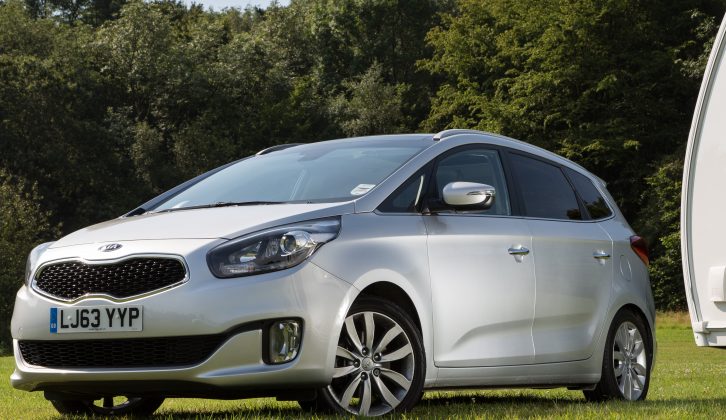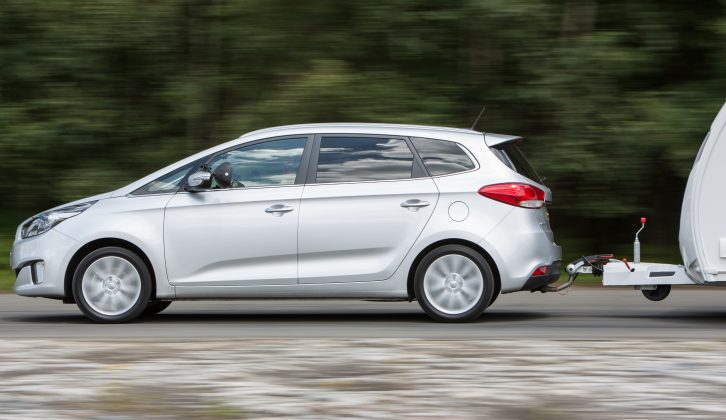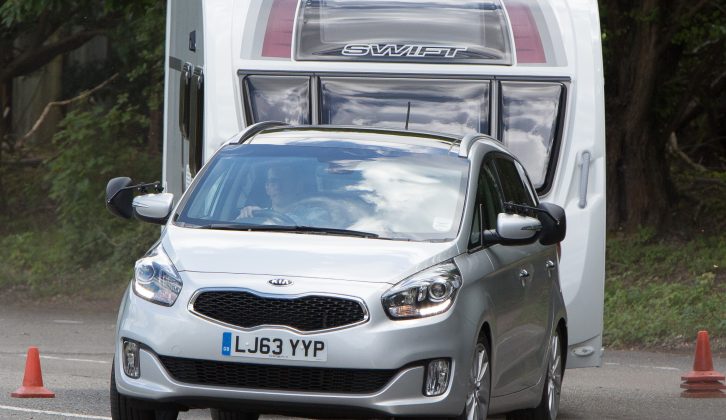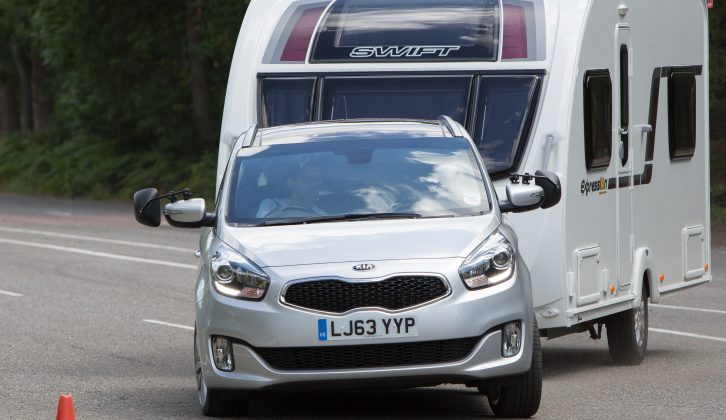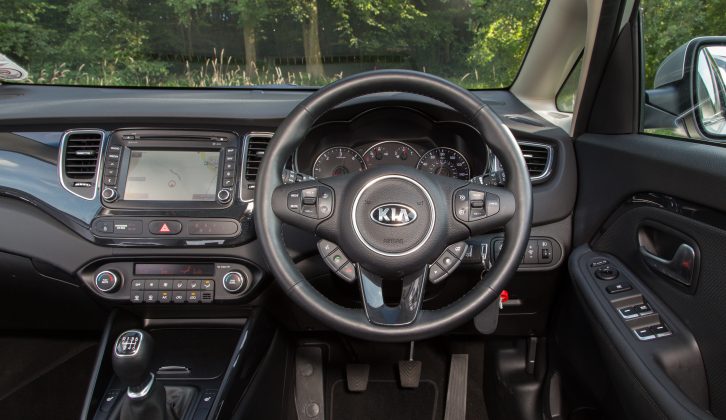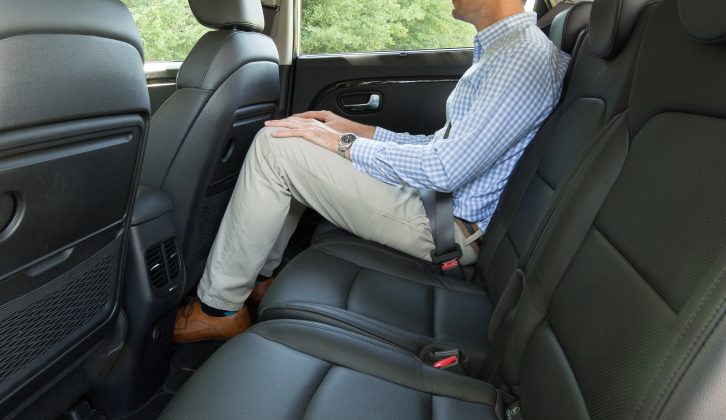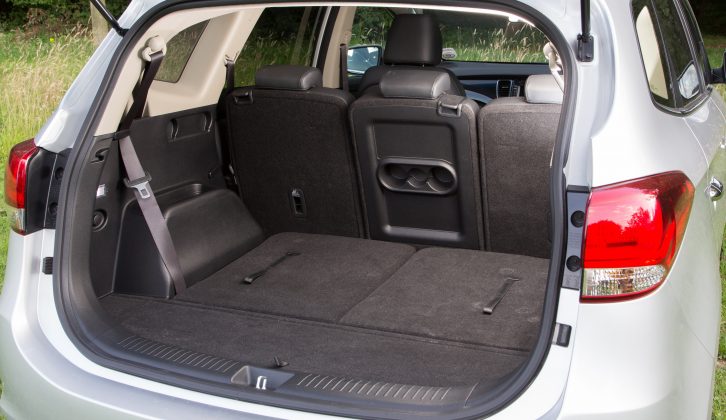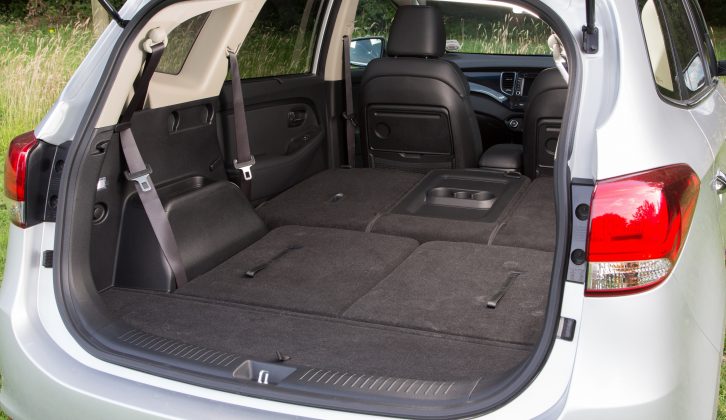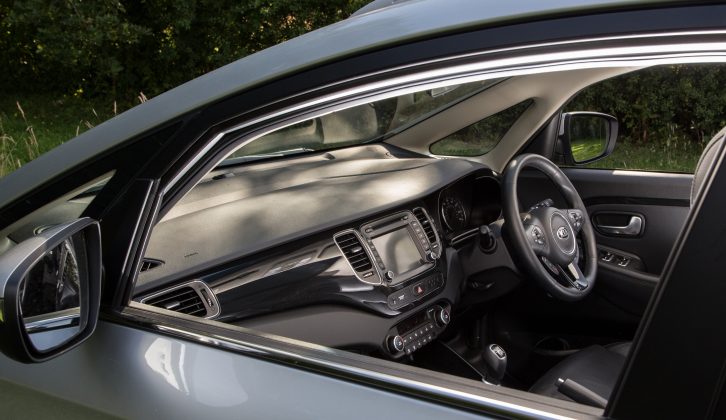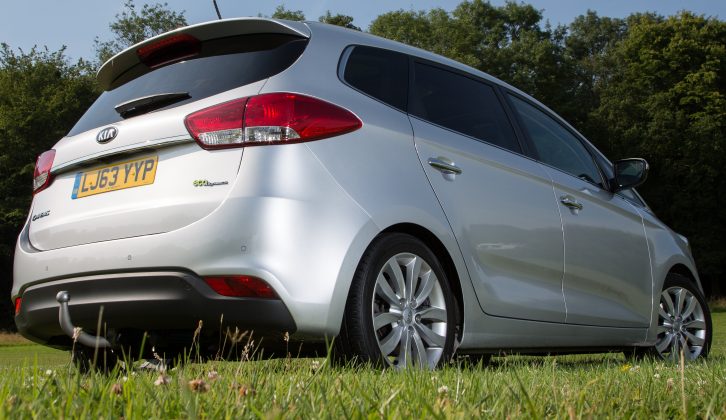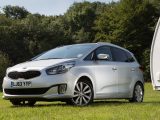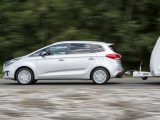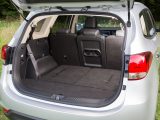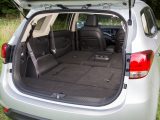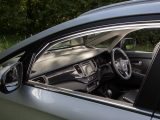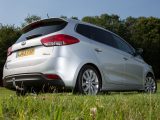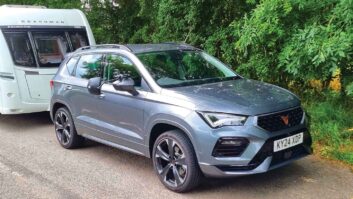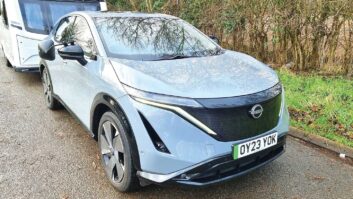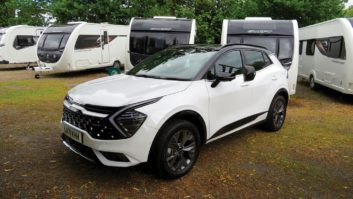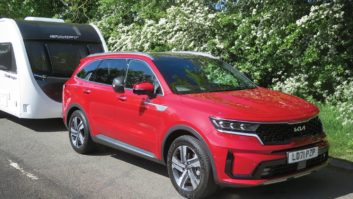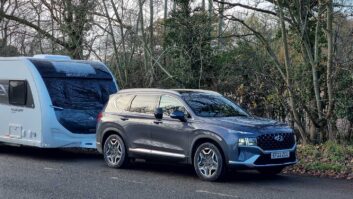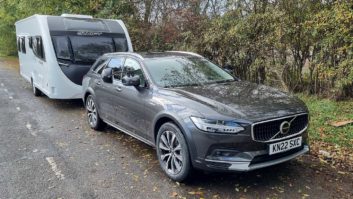Verdict
The Kia Carens is an OK car in some respects and a very good one in others. What tow car potential does it have? Well, we think it’s solid, but not outstanding. The relatively high kerbweight counts to its advantage and the engine has enough muscle for reasonable performance, but the Carens doesn’t have the unflappable feel that characterises the best tow cars.
It’s reasonably happy at motorway speeds, but it squats down on its rear suspension if the boot is heavily loaded and self-levelling suspension isn’t available to compensate for this.
In an emergency lane-change the Kia shows its limitations, with lots of lean, limited grip, and too much pushing and pulling from the caravan. Firmer suspension would make the Carens a better tow car, but the comfort-first approach does make the Kia a pleasant car to travel in as long as the driver doesn’t try to hustle it along.
It’s not fun to drive but that’s hardly the point with an MPV. It’s an easy and relaxed solo drive, although judging where the front of the car is when parking isn’t easy.
The cabin is the Kia’s strongest point. There’s plenty of space in the first two rows, and while row three is cramped, it’s fine for occasional use or short trips. You’ll run out of fingers and toes before you’ve counted all the permutations you can coax from the folding and sliding seats, and as a five-seater it boasts a boot with a healthy size.
All the usual Kia virtues of strong standard equipment and a seven-year warranty apply, so you can buy one with confidence. In the final analysis it’s a better MPV than it is a tow car.
Pros
The cabin is where the Carens really excels
The Kia Carens gives passengers a pleasant, comfortable ride
It comes with Kia’s seven-year warranty
It’s fuel efficient and will not be too expensive to insure
Cons
It leaned heavily and had limited grip in our lane-change test
Firmer suspension would make the Kia Carens a better tow car
Parking is difficult, because it is not easy to judge where the front of the car is
Kia may be known for its SUVs, but its MPVs also have a strong reputation in towing circles. Introduced last year, the Kia Carens is the manufacturer’s latest seven-seater. The range starts from £17,095, but Practical Caravan’s expert reviewers tested the range-topping 1.7 CRDi 3 Sat-Nav costing £25,050. It promises plenty of kit, a practical cabin, impressive economy and a seven-year warranty.
A seven-seat MPV should offer plenty of space and flexible seating for your caravan holidays. The test team also looked for clever storage solutions and enough room for a family’s luggage. As a tow car, they checked whether the Carens could prove itself stable with enough power to pull any suitably matched caravan comfortably over long distances.
You’ll run out of fingers and toes before you’ve counted all the permutations you can coax from the Kia Carens's folding and sliding seats
Towing
A healthy kerbweight is usually a good starting point for a tow car. The kerbweight, depending on the version, is between 1591kg and 1716kg for the Kia Carens. That compares well with the 1505kg kerbweight of the Citroën Grand C4 Picasso, which won the Best MPV prize at the 2014 Tow Car Awards.
Even taking a cautious approach and using the lower of Kia’s two figures for matching purposes gives an 85% match figure of 1352kg. The legal towing limit is 1500kg, and the towball limit is 75kg.
Numbers don’t tell the whole story, though. While the Kia is heavier than its French rival, it’s not as secure when towing. Our team hitched up to a Swift Expression 514 with a mass in running order (MiRO) of 1256kg and towed on the road and at the test track.
At the legal limit the Kia felt reasonably settled, holding a straight course unless caught out by a strong gust of wind. Soft suspension allows the car to seem a bit loose on bumpy roads, and our testers would prefer a more tied-down feel. This might compromise ride comfort at lower speeds, but it’s a price worth paying for a more precise and controlled ride.
In the emergency lane-change test, the car leaned heavily and was short of grip, even on a dry track. On high-speed runs, the caravan could be felt pushing and pulling at the back of the car. There was never cause for concern that the caravan was about to take charge, but the Carens didn’t inspire confidence, either.
The brakes also proved no better than average. In normal towing, they felt responsive enough and easy to apply smoothly, but when asked to perform an emergency stop from 30mph, the Kia needed 11.5m to come to a halt. That’s longer than you’d expect on dry Tarmac.
Our reviewers were happier with the performance from the 1.7-litre engine. The Kia diesel is further proof that you can’t judge an engine by its capacity, with a punchy 244lb ft of torque to call upon from 2000 to 2500rpm. As long as you don’t let the revs drop much below 2000rpm, there’s enough muscle to pull a tourer at a decent pace, and to cope with hilly roads. With the Swift in tow, the Kia pulled from 30-60mph in 16.2 seconds.
It took a firm pull, but the handbrake held car and caravan still on a 1-in-6 slope. The car needed plenty of revs to pull to the top, but it coped well.
One issue the team noticed when towing with a load of camera gear in the boot was a tendency for the Carens to sit low at the back, which made it easy to spin the front wheels when pulling away from junctions. It’s a shame that self-levelling suspension isn’t available.
Our experts were also concerned about the installation of the towing electrics. They’re a long way under the bumper. This may keep the rear of the car looking neat, but it makes hooking up the electrics fiddly.
The Kia Carens performs reasonably well and it’s stable enough at motorway speeds. However, a more firmly controlled suspension and brakes with more stopping power in an emergency would be better.
Everyday Driving
Soft suspension may not be ideal for towing, but it makes more sense in day-to-day driving. If you’re going to drive the Kia Carens with up to seven people inside, everyone might as well be comfortable.
Around town, the Kia rides smoothly and, as long as you’re not in a rush, it’s happy enough on country roads, too. Hurry along a poorly surfaced road, though, and the Carens can be too soft and short of body control for its own good.
The Flex Steer system offers three modes, which gives drivers a choice of more heavily weighted steering (Sport), very light steering for parking (Comfort) or something in the middle (Normal). Because there’s nothing very sporty about the car, our experts didn’t feel the need to use the Sport setting, but they recognised the benefit of Comfort for slightly built or older drivers.
When parking, it’s not easy to judge the extremities of the Kia Carens, especially the front of the car which drops away steeply. The standard-fit reversing camera comes in handy when squeezing into a small parking spot. It’s very useful when hitching up, too.
On the motorway the Kia’s cabin is quiet. The engine stays in the background and wind and road noise are both suppressed reasonably well.
Don’t expect much in the way of excitement, but as a comfortable everyday car, the Kia Carens is a success.
Space
From behind the wheel, the Kia Carens is a decent enough car. The design of the cabin is where it really excels, though. It might not be as stylish inside as a Citroën Grand C4 Picasso, but it’s a very practical and well thought-out MPV.
The driver and passenger get plenty of space, although if you are tall and like to drive with the seat set high, it’s worth noting that the panoramic sunroof (standard on models with the 3 specification) steals headroom. For the most part, the instruments are well laid-out and easy to use, although our testers found the touch-screen control for the stereo and sat-nav took some getting used to.
The rear doors open wide, making it easy to climb into the middle row of seats. The opening also helps if you’re strapping a small child into a safety seat. There are picnic tables and map pockets on the back of the front seats, and air vents between them to send chilled air to the second row. Two storage compartments are hidden under the floor.
The middle row slides forward to give those in seats six and seven more legroom. The third row isn’t as accommodating, but you can say the same of the rearmost seats in most MPVs.
Seats six and seven are likely to get only occasional use, so they fold into the floor to create a useful 492 litres of luggage space. Fold the middle row down as well and there are 1650 litres for larger loads. If you need to load all the way to the ceiling, you can store the parcel shelf under the boot floor – another practical touch.
The Kia’s clever and roomy cabin is a definite strength, when assessing what tow car potential this model has for your caravan holidays.
Running Costs
You could argue that the Kia Carens in spec 1 and 2 is better value than the range-topping 3 Sat-Nav, but the cheaper models aren’t available with the most powerful diesel as tested here. Even so, at £25,050 the Carens is competitive with rivals, and research by What Car?’s Target Price team shows that discounts of £2000 or more are there for the taking. In fact, on cars registered before the end of September 2014, Kia is offering a discount of £1400 – and you don’t have to haggle to get it.
It’s worth making sure you get as much off the asking price as you can, since the Kia holds on to only 32% of its original price after three years.
Nevertheless, the Kia Carens has other strengths that make it a good long-term buy. Kia finished a respectable ninth out of 26 brands in the JD Power Customer Satisfaction Survey and, if anything does go wrong, there’s the reassurance of Kia’s seven-year, 100,000-mile warranty. A five-star safety rating from Euro NCAP is another advantage.
Running costs should be affordable, with an insurance grouping of 16 and an official combined fuel consumption figure of 56.4mpg. We achieved an impressive 29.2mpg towing on a mixture of B-roads, A-roads and motorways.
Aside from its modest resale values, the Kia Carens makes a very sensible buy.
Technical Specifications
| Engine Size | 1685 cc |
| Kerbweight | 1591 kg |
| 85% KW | 1352 kg |
| Towball Limit | 75 kg |
| Maximum Towing Limit | 1500 kg |
| Power | 134 bhp |
| Torque | 244 lb ft |
| Offical MPG | 56.4 mpg |
| CO₂ | 132 g/km |
